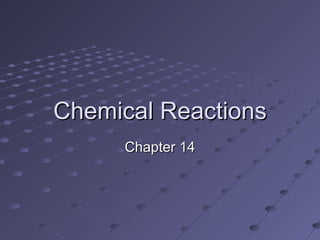
14 chemical reations
- 1. Chemical Reactions Chapter 14
- 2. When a chemical goes through a Chemical Reaction one or more substances are changed to new substances
- 3. Signs of Chemical Reactions Gas Formation Solid Formation (called precipitate) Energy is released Heat Light Electricity Energy taken in Color change Most important: The formation of a new substance that has different properties.
- 5. Not all signs happen for each reaction and some are subtle
- 6. Chemical and Physical Properties change!
- 8. Question ??
- 9. Hypothesis ??
- 10. Materials Glass container with ¼ cup Hydrogen Peroxide. 2 Square inches of steel wool. Stopper Balloon
- 11. Steps Write 1-2 paragraphs on your observation of the materials provided. Put balloon over rubber stopper. Place Steel Wool into glass container. Place rubber stopper firmly over the opening of the glass container. Place on counter and make daily written observations.
- 12. Conclusions How did you know that a chemical reaction took place? (what signs of a chemical reaction did you observe?)
- 13. Finished Lab Typed in order Follow our lab format Be complete and include observation data. Due _____________.
- 14. Homework Read p 388-391 Section Review p 391
- 15. Quiz Define Chemical Reaction: What is a precipitate? List 2 signs of a chemical reaction: T/F Steam from a teapot means a chemical change has taken place. T/F During a Chemical reaction the bonds are broken and the atoms rearrange with new bonds.
- 16. Answers The process by which one or more substances change to produce a new or different substance. A solid formed by a chemical reaction in a solution. Gas, Energy, Precipitate, Color, New Substance. F T
- 17. Types of Chemical Reactions A process by which one or more substances change to make one or more new substances.
- 18. Synthesis Reactions Two or more compounds combine to form a new substance.
- 19. Decomposition Reactions A single compound breaks down to form two or more simpler substances.
- 20. Single-Displacement Reactions One element or radical takes the place of another in a compound.
- 21. Cu + 2AgNO3 2Ag+Cu(NO3)2
- 22. Double-Displacement Reaction A gas, a solid precipitate, or a molecular compound forms from exchanging ions.
- 23. NaCl + AgF NaF + AgCl
- 24. Definitions Reactants: The starting material in a chemical reaction. Products: The new substance formed from a chemical reaction.
- 25. Law of Conservation of Mass Antoine Lavoisier (1790) Mass cannot be created or destroyed in ordinary chemical and physical changes. The total mass never changes
- 26. Homework Read p 398-401 Section Review p 401
- 27. Quiz What is a synthesis reaction? What is a decomposition reaction? What are single-displacement reactions? What are double-displacement reactions?
- 28. Answers 2 or more substances combine to form a new compound A reaction in which a single compound breaks down to form 2 or more simpler substances. A reaction in which one element or radical takes the place of another element or radical in the compound. A reaction in which a gas, a solid precipitate, or a molecular compound forms from exchange of ions between 2 compounds.
- 29. Balancing Chemical Equations
- 30. Counting Atoms 4Al2(SO4)3 8 Aluminum 12 Sulfur 48 Oxygen
- 31. You Try 2Na3PO4
- 32. Steps 1. Count the Atoms 2. Place a coefficient in front of the second part if the equation if necessary 3. Place a coefficient in front of the first part of the equation to balance the atoms. Atoms from the left side must equal the atoms from the right side of the equation.
- 33. ___AlBr3 + ___K ___KBr + ___Al
- 34. ___AlBr3 + ___K _3_KBr + ___Al
- 35. ___AlBr3 + _3_K _3_KBr + ___Al
- 36. _1_AlBr3 + _3_K _3_KBr + ___Al
- 37. _1_AlBr3 + _3_K _3_KBr + _1_Al
- 38. ___Mn + ___HI ___H2 + ___MnI3 2 Mn + 6 HI >>> 3 H2 + 2 MnI3
- 39. ___AlBr3 + ___K2SO4 ___KBr +___Al2(SO4)3 2 AlBr3 + 3 K2SO4 >> 6 KBr + 1 Al2(SO4)3
- 40. Homework Read p 392-397 Section Review p 397
- 41. Quiz How many atoms are in C14HgCl5? Define Reactant: Define Product: What is the Law of Conservation of Mass? Balance: ___Na + ___Cl2 >>> ___NaCl2
- 42. Answers 28 The starting material in a chemical reaction. Substances formed from a chemical reaction. Mass is neither created or destroyed in ordinary chemical and physical changes. Na + 1 Cl2 >>> NaCl2
- 43. Chemical Equations Sheet 1
- 44. Homework Read p 402-407 Section Review p 407
- 45. Chemical Equations Sheet 2
- 46. p 410 1-15 all, 21, 22
- 48. Question ??
- 49. Hypothesis ??
- 50. Materials White Glue Borax solution, 40g/L Paper cup and stirrer Rubber gloves Goggles Plastic bag
- 51. Steps Write observations of each material. Place the Borax solution in the white glue. Stir and mix well. Place new mixture in plastic bag. Write final observations.
- 52. Observations What is each material like. Consistency, state, appearance, etc. What happen when they were mixed together? Compare the properties of the glue with the new substance. Predict the properties of the material if less Borax is used. How do you know a chemical reaction took place?
- 53. Conclusion Two Paragraphs Did the experiment support your hypothesis and why? What did you learn?
- 54. Final lab write up Follow as we have all year. Due: ___________